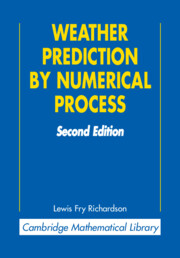Book contents
- Frontmatter
- FOREWORD
- Contents
- PREFACE
- GUIDING SIGNS
- CHAP. I SUMMARY
- CHAP. II INTRODUCTORY EXAMPLE
- CHAP. III THE CHOICE OF COORDINATE DIFFERENCES
- CHAP. IV THE FUNDAMENTAL EQUATIONS
- CHAP. V FINDING THE VERTICAL VELOCITY
- CHAP. VI SPECIAL TREATMENT FOR THE STRATOSPHERE
- CHAP. VII THE ARRANGEMENT OF POINTS AND INSTANTS
- CHAP. VIII REVIEW OF OPERATIONS IN SEQUENCE
- CHAP. IX AN EXAMPLE WORKED ON COMPUTING FORMS
- CHAP. X SMOOTHING THE INITIAL DATA
- CHAP. XI SOME REMAINING PROBLEMS
- CHAP. XII UNITS AND NOTATION
- INDEX OF PERSONS
- INDEX OF SUBSIDIARY SUBJECTS
PREFACE
Published online by Cambridge University Press: 06 July 2010
- Frontmatter
- FOREWORD
- Contents
- PREFACE
- GUIDING SIGNS
- CHAP. I SUMMARY
- CHAP. II INTRODUCTORY EXAMPLE
- CHAP. III THE CHOICE OF COORDINATE DIFFERENCES
- CHAP. IV THE FUNDAMENTAL EQUATIONS
- CHAP. V FINDING THE VERTICAL VELOCITY
- CHAP. VI SPECIAL TREATMENT FOR THE STRATOSPHERE
- CHAP. VII THE ARRANGEMENT OF POINTS AND INSTANTS
- CHAP. VIII REVIEW OF OPERATIONS IN SEQUENCE
- CHAP. IX AN EXAMPLE WORKED ON COMPUTING FORMS
- CHAP. X SMOOTHING THE INITIAL DATA
- CHAP. XI SOME REMAINING PROBLEMS
- CHAP. XII UNITS AND NOTATION
- INDEX OF PERSONS
- INDEX OF SUBSIDIARY SUBJECTS
Summary
THE process of forecasting, which has been carried on in London for many years, may be typified by one of its latest developments, namely Col. E. Gold's Index of Weather Maps. It would be difficult to imagine anything more immediately practical. The observing stations telegraph the elements of present weather. At the head office these particulars are set in their places upon a large-scale map. The index then enables the forecaster to find a number of previous maps which resemble the present one. The forecast is based on the supposition that what the atmosphere did then, it will do again now. There is no troublesome calculation, with its possibilities of theoretical or arithmetical error. The past history of the atmosphere is used, so to speak, as a full-scale working model of its present self.
But—one may reflect—the Nautical Almanac, that marvel of accurate forecasting, is not based on the principle that astronomical history repeats itself in the aggregate. It would be safe to say that a particular disposition of stars, planets and satellites never occurs twice. Why then should we expect a present weather map to be exactly represented in a catalogue of past weather? Obviously the approximate repetition does not hold good for many days at a time, for at present three days ahead is about the limit for forecasts in the British Isles.
- Type
- Chapter
- Information
- Weather Prediction by Numerical Process , pp. xi - xiiiPublisher: Cambridge University PressPrint publication year: 2007

